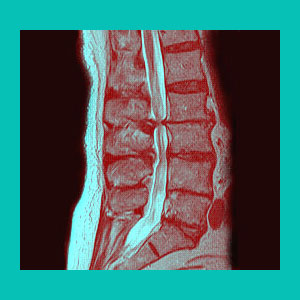
Many people are interested in finding herniated disc photos so they can see for themselves exactly what a bulging or ruptured disc looks like. While this is completely understandable, I often caution patients to view diagnostic imaging films with a knowledgeable mindset or else risk becoming affected by the nocebo effect often produced by the disturbing images.
It is true that most herniated discs look rather scary on film, but their appearance is certainly not indicative of the type of symptoms they are likely to produce. Remember, proven research does not link most herniations to the occurrence of chronic pain.
X-Ray Herniated Disc Photos
X-ray films will not show herniated discs, although it will be obvious that some disc abnormality exists in imaged intervertebral levels. In some circumstances, a herniated disc or degenerated disc may image virtually identically. The intervertebral space will look diminished, with the vertebral bones closer together than normal.
For conditions which have been there for some time, it is normal and expected to see degenerative changes in the vertebrae, as well, including arthritic changes, such as osteophyte formation and endplate degeneration. Vertebrae may demonstrate considerable spurring if the disc space is very close together. Some calcified herniations or desiccated discs may appear bony on x-ray imaging, as well.
MRI Herniated Disc Photos
An MRI or CT scan is far better for diagnosing disc issues, since this type of advanced imaging study details the soft tissues of the spine, as well as the bones. MRI is also useful in determining if a herniation is indeed affecting surrounding nerve tissue, but is rarely conclusive in this regard.
Many doctors assume nerve involvement exists when the patient experiences symptoms in conjunction with a herniated disc in the region; yet this assumption is unenlightened and may doom patients to a long and unsuccessful quest for disc pain relief.
It is crucial to compare diagnostic imaging studies to the exact symptoms experienced and look for inconsistencies in the symptomatic expression. If this was done more often, misdiagnosis would not be such an epidemic issue in the medical sector.
In order to minimize your risks of being misdiagnosed as suffering from a disc protrusion, always evaluate disc pathologies with the help of a qualified spinal neurologist.
Photos of Herniated Discs
Seeing an actual image of your herniated disc will not help you to heal or resolve any painful complaint. In fact, visualizing the condition may increase its psychological effect on you and allow the pain syndrome to become accepted into your belief system. These are very real concerns which can lead to the perpetuation and intensification of actual disc pain and misdiagnosed perceived disc pain syndromes in countless millions of patients.
In order to balance out the nocebo effect of a herniated disc picture, I highly recommend learning the facts about herniations and understanding why most are not health issues.
Some patients find knowledge therapy to be helpful in reducing the emotional impact of the diagnostic process. I would agree that this approach is beneficial for many patients who are full of anxiety once they have received a positive diagnosis of disc herniation.
Herniated Disc > Intervertebral Discs > Herniated Disc Photos




